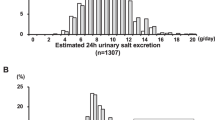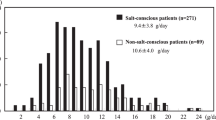Abstract
Background/objectives
The aim of the present study was to validate a short questionnaire on habitual dietary salt intake, to quickly and easily identify individuals whose salt consumption exceeds recommended levels.
Subjects/methods
A total of 1131 hypertensive subjects participating in the MINISAL-SIIA study were included in the analysis. Anthropometric indexes, blood pressure, and 24-h urinary sodium excretion (NaU) were measured. A fixed-sequence questionnaire on dietary salt intake was administered.
Results
NaU was significantly associated with scores, with a linear association across categories (p for trend <0.0001). In addition, participants who achieved a total score above the median value (eight points) had significantly higher NaU than those whose score was below median (p < 0.0001). In the total sample, the prevalence of “high NaU” (NaU > 85 mmol/day) and “very high NaU” (NaU > 170 mmol/day) was 86 and 35%, respectively. The score of the questionnaire had a significant ability to detect both “high NaU”—with a specificity of 95% at the score of 10 points—and “very high NaU”—with a specificity of 99.6% at score of 13 points.
Conclusions
The main results of the study indicates that a higher score of this short questionnaire is distinctive of habitual high salt consumption in hypertensive patients.
This is a preview of subscription content, access via your institution
Access options
Subscribe to this journal
Receive 12 print issues and online access
$259.00 per year
only $21.58 per issue
Buy this article
- Purchase on Springer Link
- Instant access to full article PDF
Prices may be subject to local taxes which are calculated during checkout


Similar content being viewed by others
References
Strazzullo P, D’Elia L, Kandala NB, Cappuccio FP. Salt intake, stroke, and cardiovascular disease: meta-analysis of prospective studies. Br Med J. 2009;339:b4567.
Aburto NJ, Ziolkovska A, Hooper L, Elliott P, Cappuccio FP, Meerpohl JJ. Effect of lower sodium intake on health: systematic review and meta-analyses. Br Med J. 2013;346:f1326.
Intersalt Cooperative Research Group. Intersalt: an international study of electrolyte excretion and blood pressure. Results for 24 h urinary sodium and potassium excretion. Br Med J. 1988;297:319–28.
He FJ, Mac Gregor GA. Importance of salt in determining blood pressure in children: meta-analysis of controlled trials. Hypertension. 2006;48:861–9.
Sacks FM, Svetkey LP, Vollmer WM, Appel LJ, Bray GA, Harsha D, et al. Effects on blood pressure of reduced dietary sodium and the Dietary Approaches to Stop Hypertension (DASH) diet. DASH-Sodium Collaborative Research Group. N Engl J Med. 2001;344:3–10.
Svetkey LP, Sacks FM, Obarzanek E, Vollmer WM, Appel LJ, Lin PH, et al. The DASH Diet, Sodium Intake and Blood Pressure Trial (DASH-sodium): rationale and design. DASH-Sodium Collaborative Research Group. J Am Diet Assoc. 1999;99:S96–104.
He FJ, Li J, Macgregor GA. Effect of longer term modest salt reduction on blood pressure: Cochrane systematic review and meta-analysis of randomised trials. Br Med J. 2013;346:f1325.
D’Elia L, Rossi G, Schiano di Cola M, Savino I, Galletti F, Strazzullo P. Meta-analysis of the effect of dietary sodium restriction with or without concomitant renin-angiotensin-aldosterone system-inhibiting treatment on albuminuria. Clin J Am Soc Nephrol. 2015;10:1542–52. https://doi.org/10.2215/CJN.09110914.
D’Elia L, Galletti F, La Fata E, Sabino P, Strazzullo P. Effect of dietary sodium restriction on arterial stiffness: systematic review and meta-analysis of the randomized controlled trials. J Hypertens. 2017. https://doi.org/10.1097/HJH.0000000000001604.
World Health Organization. WHO guideline: sodium intake for adults and children. Geneva: World Health Organization (WHO); 2012.
Galletti F, Agabiti-Rosei E, Bernini G, Boero R, Desideri G, Fallo F, MINISAL-GIRCSI Program Study Group, et al. Excess dietary sodium and inadequate potassium intake by hypertensive patients in Italy: results of MINISAL-SIIA study program. J Hypertens. 2014;32:48–56.
Donfrancesco C, Ippolito R, Lo Noce C, Palmieri L, Iacone R, Russo O, et al. Excess dietary sodium and inadequate potassium intake in Italy: results of the MINISAL study. Nutr Metab Cardiovasc Dis. 2013;23:850–6.
World Health Organization. World Health Organization forum on reducing salt intake in populations. Reducing salt intake in populations: report of a WHO forum and technical meeting. Paris: World Health Organization; 2006.
Rakova N, Juttner K, Dahlmann A, Schröder A, Linz P, Kopp C, et al. Long-term space flight simulation reveals infradian rhythmicity in human Na(+) balance. Cell Metab. 2013;17:125–31.
Titze J, Dahlmann A, Lerchl K, Kopp C, Rakova N, Schröder A, et al. Spooky sodium balance. Kidney Int. 2014;85:759–67.
Lerchl K, Rakova N, Dahlmann A, Rauh M, Goller U, Basner M, et al. Agreement between 24-hour salt ingestion and sodium excretion in a controlled environment. Hypertension. 2015;66:850–7.
Ji C, Miller MA, Venezia, Strazzullo P, Cappuccio FP. Comparisons of spot vs 24-h urine samples for estimating population salt intake: validation study in two independent samples of adults in Britain and Italy. Nutr Metab Cardiovasc Dis. 2014;24:140–7.
Sakaki M, Tsuchihashi T, Arakawa K, Fukui H, Kameda W, Tominaga M. Long-term variability of urinary salt excretion and blood pressure in hypertensive patients. Hypertens Res. 2014;37:939–43.
Weaver CM, Martin BR, McCabe GP, McCabe LD, Woodward M, Anderson CA, et al. Individual variation in urinary sodium excretion among adolescent girls on a fixed intake. J Hypertens. 2016;34:1290–7.
Peng Y, Li W, Wang Y, Chen H, Bo J, Wang X, et al. Validation and assessment of three methods to estimate 24-h urinary sodium excretion from spot urine samples in Chinese adults. PLoS ONE. 2016;11:e0149655 https://doi.org/10.1371/journal.
Cogswell ME, Wang CY, Chen TC, Pfeiffer CM, Elliott P, Gillespie CD, et al. Validity of predictive equations for 24-h urinary sodium excretion in adults aged 18-39 y. Am J Clin Nutr. 2013;98:1502–13.
Dougher CE, Rifkin DE, Anderson CA, Smits G, Persky MS, Block GA, et al. Spot urine sodium measurements do not accurately estimate dietary sodium intake in chronic kidney disease. Am J Clin Nutr. 2016;104:298–305.
Charlton KE, Steyn K, Levitt NS, Jonathan D, Zulu JV, Nel JH. Development and validation of a short questionnaire to assess sodium intake. Public Health Nutr. 2008;11:83–94.
Ferreira-Sae MC, Gallani MC, Nadruz W, Rodrigues RC, Franchini KG, Cabral PC, et al. Reliability and validity of a semi-quantitative FFQ for sodium intake in low-income and low-literacy Brazilian hypertensive subjects. Public Health Nutr. 2009;12:2168–73.
Murakami K, Sasaki S, Uenishi K, Japan Dietetic Students’ Study for N, Biomarkers G. The degree of misreporting of the energy-adjusted intake of protein, potassium, and sodium does not differ among under-, acceptable, and over-reporters of energy intake. Nutr Res. 2012;32:741–50.
Day N, McKeown N, Wong M, Welch A, Bingham S. Epidemiological assessment of diet: a comparison of a 7-day diary with a food frequency questionnaire using urinary markers of nitrogen, potassium and sodium. Int J Epidemiol. 2001;30:309–17.
Sasaki S, Ishihara J, Tsugane S. Validity of a self-administered food frequency questionnaire in the 5-year follow-up survey of the JPHC Study Cohort I to assess sodium and potassium intake: comparison with dietary records and 24-hour urinary excretion level. J Epidemiol. 2003;13:102–5.
Freedman LS, Commins JM, Moler JE, Willett W, Tinker LF, Subar AF, et al. Pooled results from 5 validation studies of dietary self-report instruments using recovery biomarkers for potassium and sodium intake. Am J Epidemiol. 2015;181:473–87.
Kelly C, Geaney F, Fitzgerald AP, Browne GM, Perry IJ. Validation of diet and urinary excretion derived estimates of sodium excretion against 24-h urine excretion in a worksite sample. Nutr Metab Cardiovasc Dis. 2015;25:771–9.
Mancia G, Fagard R, Narkiewicz K, Redón J, Zanchetti A, Böhm M, European Society of Hypertension, European Society of Cardiology, et al. 2013 ESH/ESC guidelines for the management of arterial hypertension: the Task Force for the Management of Arterial Hypertension of the European Society of Hypertension (ESH) and of the European Society of Cardiology (ESC). J Hypertens. 2013;31:1281–357.
Leclercq C, Ferro-Luzzi A. Total and domestic consumption of salt and their determinants in three regions of Italy. Eur J Clin Nutr. 1991;45:151–9.
Anderson CA, Appel LJ, Okuda N, Brown IJ, Chan Q, Zhao L, et al. Dietary sources of sodium in China, Japan, the United Kingdom, and the United States, women and men aged 40 to 59 years: the INTERMAP Study. J Am Diet Assoc. 2010;110:736–45.
Leclercq C, Arcella D, Piccinelli R, Sette S, Le Donne C, Turrini A, on behalf of the INRAN-SCAI 2005–06 Study Group. The Italian national food consumption survey INRAN-SCAI 2005-06: main results in terms of food consumption. Public Health Nutr. 2009;12:2504–32.
Stanhewicz AE, Kenney WL. Determinants of water and sodium intake and output. Nutr Rev. 2015;73:73–82.
Bertino M, Beauchamp GK, Riskey DR, Engelman K. Taste perception in three individuals on a low sodium diet. Appetite. 1981;2:67–73.
Hanley JA, McNeil BJ. The meaning and use of the area under a receiver operating characteristic (ROC) curve. Radiology. 1982;143:29–36.
Piovesana Pde M, Sampaio Kde L, Gallani MC. Association between taste sensitivity and self-reported and objective measures of salt intake among hypertensive and normotensive individuals. ISRN Nutr. 2012;2013:301213.
Keogh JB, Lange K, Hogarth R, Clifton PM. Food contributing to sodium intake and urinary sodium excretion in a group of Australian women. Public Health Nutr. 2013;16:1837–42.
Pereira TS, Benseñor IJ, Meléndez JG, Faria CP, Cade NV, Mill JG, et al. Sodium and potassium intake estimated using two methods in the Brazilian Longitudinal Study of Adult Health (ELSA-Brasil). Sao Paulo Med J. 2015;133:510–6.
Acknowledgements
The MINISAL-SIIA is a working group of Italian Society of Hypertension (SIIA) and part of the MINISAL-GIRCSI Program, funded by the Italian Ministry of Health (Ministero della Salute) Center for Disease Prevention and Control (CCM) within the framework of the Program Guadagnare Salute (coordinator, Dr. Daniela Galeone).
Author contributions
Conception and design: GF. Analysis and interpretation of the data: D’EL, GF. Drafting of the article: D’EL, MM, SP, GF. Final approval of the article: Minisal Group. Statistical expertise: D’EL, GF. Collection and assembly of data: D’EL, MM, GF.
MINISAL-SIIA Study Group
Coordinator: Galletti F., Collaborators: Agabiti-Rosei E., Arcangeli E., Artom A., Barbato A., Barbiero M., Belfiore A., Bernini G., Boero R., Berra E., Biggi A., Borgheresi P., Borghi C., Bosio A., Caiazza A., Caielli P., Caló L.A., Castellano M., Catena C., Cerrato F., Cilia C., Cipollini F., Crippa M., Cuspidi C., D’Elia L., D’Avino M., De Giorgi G.A., De Luca N., De Pergola G., Del Giudice A., Desideri G., Fallo F., Ferri C., Galeone D., Garavelli G., Gaudio G., Giacchetti G., Gidaro B., Giovannetti R., Grandi A., Guglielmi M., Iacoviello L., Leonardis D., Lonati C., Lonati L.M., Malatino L., Mallamaci F., Manfredi M., Maresca A.M., Marzano L., Massara C., Merletti L., Meschi M., Modesti S., Montanari A., Morganti A., Musiari L., Musso N., Nardecchia A., Nazzaro P., Pallisco O., Panichi V., Parati G., Pascale C., Pini C., Pirola I., Pucci G., Rabbia F., Rescaldani M., Ronchi E., Rossi E., Rossi G., Sala C., Sarzani R., Sechi L.A., Silvestris F., Stancanelli B., Strazzullo P., Trimarco B., Ungar A., Veglio F., Veronesi M., Vinella L.
Author information
Authors and Affiliations
Consortia
Corresponding author
Ethics declarations
Conflict of interest
GF is member of the advisory board of the Italian Society of Hypertension. SP is President of the Italian Society of Human Nutrition, Scientific Coordinator of the Interdisciplinary Working Group for Reduction of Salt Intake in Italy (GIRCSI), member of the committee for the preparation of the Italian Nutritional Guidelines and an unpaid member of WASH (World Action in Salt and Health). The remaining authors declare that they have no conflict of interest.
Additional information
The members of the Group are listed below Acknowledgements.
Electronic supplementary material
Rights and permissions
About this article
Cite this article
D’Elia, L., Manfredi, M., Strazzullo, P. et al. Validation of an easy questionnaire on the assessment of salt habit: the MINISAL-SIIA Study Program. Eur J Clin Nutr 73, 793–800 (2019). https://doi.org/10.1038/s41430-018-0204-0
Received:
Revised:
Accepted:
Published:
Issue Date:
DOI: https://doi.org/10.1038/s41430-018-0204-0
This article is cited by
-
Prediction of 24-hour sodium excretion from spot urine samples in South African adults: a comparison of four equations
Journal of Human Hypertension (2020)



